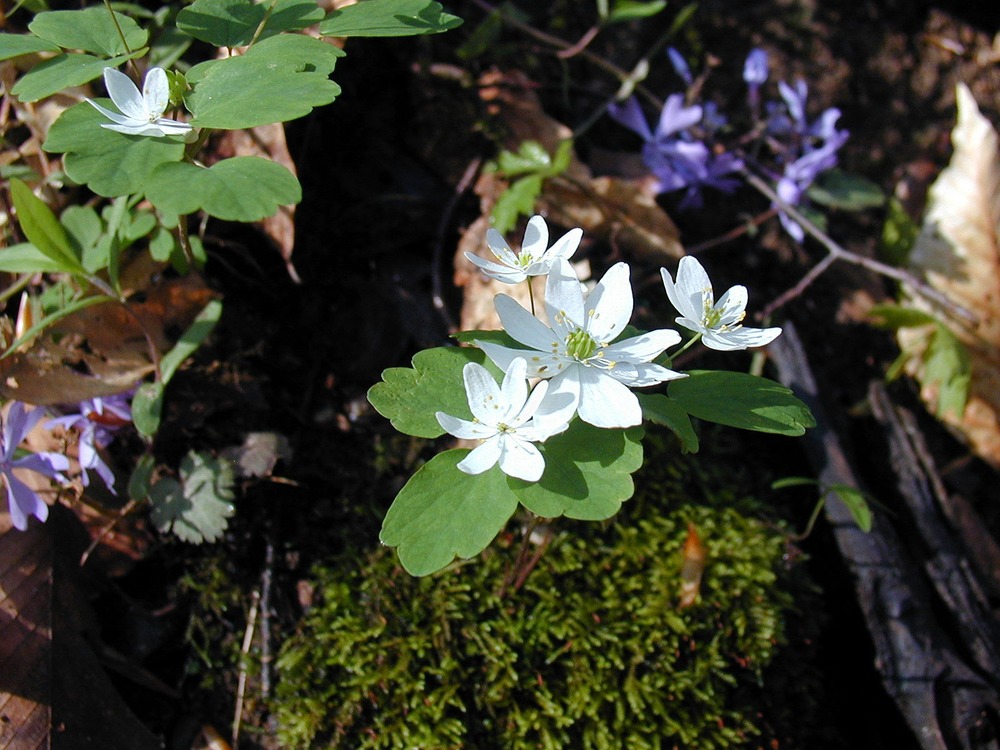Thalictrum thalictroides – Rue-anemone
Thalictrum thalictroides (tha-LICK-trum tha-LICK-troy-dees)
Rue-anemone
You might encounter the Rue-anemone on a spring hike in the North Eastern United States. It typically grows on wooded slopes and ridges and can be spotted flowering in April and May. The long flowering period makes the white-flowered Thalictrum thalictroides an ideal choice for a shade garden requiring some early color. Even after the flowers have faded, the Rue-anemone gracefully goes into its dormancy by leaving attractive green fruit called achenes, extending the period of interest.

Thalictrum thalictroides at Shenandoah National Park
Another benefit of Thalictrum thalictroides is the relative tolerance to mammalian browsing due to the toxicity of Ranunculaceae plant family. However, the somewhat tuberous roots can be used to make teas that inhabitants of the first nation used as a remedy for diarrhea and other digestive problems.
Something to be aware of when sourcing this plant for your garden is that there is some dispute to its binomial nomenclature, as some taxonomists categorize Thalictrum in the monospecific genus, Anemonella.
Thalictrum thalictroides can be confused with False rue-anemone, Enemion biternatum. The best way to distinguish between the two is to observe the flower placement and composition. T. thalictroides bears its flower in a cluster above a whorl of leaf-like bracts, while the flowers of E. biternatum are borne in its leaf axils. Rue-anemone has much more variation in its flower size and therefore, a varied number of sepals while False rue-anemone will always possess five white sepals. Lastly, False rue-anemone has no more than six green carpels while Rue-anemone can have up to fifteen.
Origin:
Thalictrum – From the Greek word thaliktron, which was used by Dioscorides to describe plants within this genus.
thalictroides – In reference to the plant’s three-lobed, dark green leaves which resemble meadow-rue (Thalictrum).
Family – Ranunculaceae
Nativity – Central and North East United States
Hardiness – USDA Zones 4-8

Blue Phlox and Rue-anemone at Mammoth Cave National Park
Description:
Form – A delicate, hairless, tuberous-rooted native that reaches heights between 4″-8″.
Foliage – Glabrous (hairless), rounded 1/2″ long leaflets on bi and tri-ternately compound leaves that arise from 4″-12″ long basal petioles.
Flower – Solitary or sometimes umbel-like inflorescence in clusters of 3-6 flowers, upward-facing, white or pink 1/2″ flowers appear from March until June depending on the area. 4-15 carpels surrounded by numerous stamens, and a cup of 5-10 pinkish sepals.

Botanical illustration of Rue-anemone from 1913
Culture:
Light – Part-full shade
Soil – Woodland soils, tolerant of drought
Propagation – Seed or division
Problems – Slugs and snails
Utilization – Shade garden, woodland naturalization, shade rock garden
Ecological benefit – Offer pollen to various bee species, but do not produce nectar. Honeybees, little carpenter bees (Ceratina spp.), cuckoo bees (Nomada spp.), mason bees (Osmia spp.), halictid bees, and andrenid bees have been observed as visitors to the flowers.
Comments – Don’t let the dainty appearance discourage you from growing this herbaceous woodland perennial. It is easy to grow and is an excellent companion for taller shade perennials like Gillenia trifoliata.
♠ You can find Rue-anemone at Amanda’s Garden, a nursery in NY specializing in native woodland perennials.
- http://www.missouribotanicalgarden.org/PlantFinder/PlantFinderDetails.aspx?kempercode=j350
- https://www.lakeforest.edu/academics/programs/environmental/courses/es203/anemonella_thalictroides.php
- https://en.wikipedia.org/wiki/Thalictrum_thalictroides


